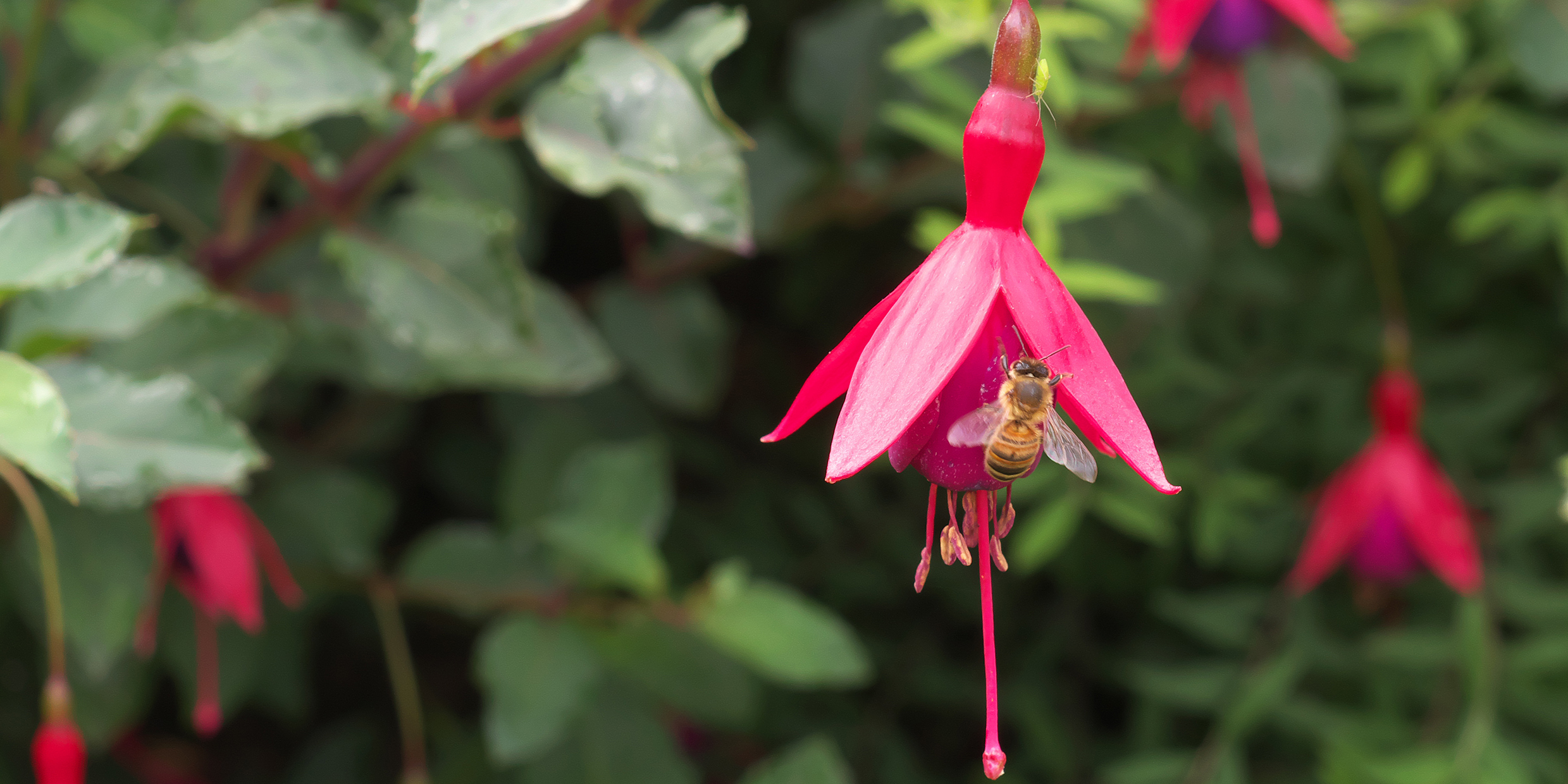Originally published 13 March 2001
“The way bees on a drowsy day suck honey from fuchsia.” At least once each year I fly back and forth to Ireland on Aer Lingus, the Irish national airline. These words are woven into the fabric that covers the airplane seats, with other brief excerpts from Irish writers. For five or six hours across the Atlantic, flight after flight, the phrase keeps jumping off the back of the seat in front of me. It lingers in my mind long after journey’s end.
“The way bees on a drowsy day suck honey from fuchsia.”
Irish friends here and abroad could not identify the author. An Internet search, too, was unsuccessful. Finally, I tried “Contact Us” on the Aer Lingus Web site. Within an hour, I had the answer back by return e‑mail: Ulick O’Connor.
The phrase is from a poem titled “The Kiss,” in which the poet recounts a very special osculation, during which “her lips on mine traced a design to show the way bees on a drowsy day…” Some kiss. Some poem.
Why did the phrase stick in my mind? Well, for one thing, the words are individually gorgeous. Suck is an Old English word, with an ancient Latin root. Each breath we take, each drop of mother’s milk, is sucked from the world.
Fuchsia found its name more recently; it commemorates the 17th-century German botanist Leonhart Fuchs. In moving from botanist to plant, the word softened, became redolent with fragrance, got juicier.
And honey. There is probably no English word that evokes more succulent imagery: golden, pure, sweet. Honeycombs spilling their luscious liquid. Oozy sensuality.
Add “bees” and “drowsy” and you have a mini-dictionary of delight.
But it is not just the words. It is what they do together. Shakespeare tried it, too: “Where the bee sucks, there suck I.” Ulick O’Connor wraps his kiss with every sense, and sucks deeply at the very essence of life.
So what does all this have to do with science?
Even a science writer has moments when he wonders what’s the point of science. Why bother with all the technical arcana, the numbers and graphs, the unlovely lingo, the experiments, dissections and cold abstractions, when all that really matters is a bee sucking honey on a drowsy day? And a kiss.
Václav Havel, Czech poet, playwright and statesman, has given passionate voice to this anti-science sentiment. He writes: “Modern science…abolishes as mere fiction the innermost foundations of our natural world…People thought they could explain and conquer nature — yet the outcome is that they destroyed it and disinherited themselves from it.”
A scientist might, for example, tag honey bees with markers to trace their travels, or fix a honey bee’s body in a wind tunnel to analyze its wing stroke. She might dissect a bee’s abdomen to study the process of partial digestion that turns nectar into honey, or search for the genes along the bee’s DNA that code for hexagonal cells.
Science turns honey into mere regurgitation, Havel might have said, and a drowsy summer day into mere numbers for temperature, humidity, and wind speed. Where in all of this is the ancient fabric of metaphor that instructed our foreparents in what really matters, and which makes a single line of Irish verse woven into upholstery fabric resonate so enduringly in the mind of at least one air traveler?
Which is the “mere fiction?” The design traced by “her lips on mine,” or the accumulated physics, chemistry, and biology that describe the bee and its honey? Fuchsia honey tastes subtly different than the honey of gorse or heather, and the chemist can tell you why, perhaps even give you the formula for those few molecules among the sugars, water, enzymes, vitamins, and minerals that are the unique signature of fuchsia. But what does any of this matter in the face of a honeyed kiss?
The poet explains the unfamiliar (the thrill of that special kiss) in terms of the familiar (bees sucking honey from fuchsia). The scientist explains the familiar (the bee, the honey) in terms of the unfamiliar (aerodynamic lift, arthropodal metabolism, genes). Both poetry and science explore the mystery of the world.
Whenever I find myself drifting into the kind of dreamy reverie that comes from reading too many poetic phrases on the backs of airplane seats, I remind myself that beauty and meaning are found at every scale of creation — at the scale of centimeters (bees and flowers and tongues), yes, but also at the scales of microns and light-years. The beauty and meaning of the very small and the very large can only be perceived through the methods of science.
It’s not one or the other, it seems to me, but both. Poetry and science. There are more kisses in the world than merely those that remind the poet of bees sucking honey on a drowsy day.



